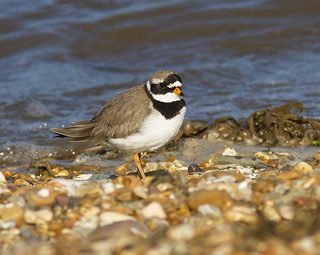 The Helford Estuary is a good place to spot Ringed Plover.
The Helford Estuary is a good place to spot Ringed Plover.
Photo: Ray Surridge
Scientific name: Charadrius hiaticula
Other common names: Common Ringed Plover, Sea Lark, Sand Lark
Conservation status: UK Birds of Conservation Concern, Amber; IUCN Red List, Least Concern.
What to look for:
- Colouring and appearance: Small wader, grey-brown upperparts and white/pale underparts. Black and white head and breast, with short orange bill and legs. In flight, a white stripe on the wings is distinctive.
- Size: 10 to 20 cm long; wingspan is up to 52 cm.
- Where: Coast, estuaries, inland gravel pits.
- Call: Listen to the whistling flight call.
- Similar species: Little Ringed Plover, which is smaller and has paler legs.
 Despite sporting a distinctive black mask and neckband, Ringed Plovers can be hard to spot on a shingly beach, with their strong markings providing an unexpectedly great camouflage against the rocks and stones. This small, rather dumpy wader breeds across northern Europe, Asia and in northeastern Canada, but towards the end of the summer migrates southwards. In Great Britain, many Ringed Plovers are resident, breeding and staying here all year. Numbers increase as birds migrate south from further north in the autumn: Britain hosts over 5,300 breeding pairs, but some 36,000 individuals arrive here as migrants to overwinter.
Despite sporting a distinctive black mask and neckband, Ringed Plovers can be hard to spot on a shingly beach, with their strong markings providing an unexpectedly great camouflage against the rocks and stones. This small, rather dumpy wader breeds across northern Europe, Asia and in northeastern Canada, but towards the end of the summer migrates southwards. In Great Britain, many Ringed Plovers are resident, breeding and staying here all year. Numbers increase as birds migrate south from further north in the autumn: Britain hosts over 5,300 breeding pairs, but some 36,000 individuals arrive here as migrants to overwinter.
Most usually spotted round the coast and on tidal estuaries, foraging for crustaceans, insects and worms to eat, they have also now colonised breeding sites inland, in gravel pits and on abandoned industrial sites. This is probably in response to loss of suitable coastal habitats during the twentieth century as a result of development. Declines in the breeding population are why the Ringed Plover has an Amber conservation rating in the UK.
 Two or three broods are raised per year, with both parents sharing incubation duties: each clutch is of about four eggs, laid between April and the middle of July on open ground where there is little vegetation. The parents defend the nest aggressively.
Two or three broods are raised per year, with both parents sharing incubation duties: each clutch is of about four eggs, laid between April and the middle of July on open ground where there is little vegetation. The parents defend the nest aggressively.
Did you know…?
…Clever trick # 1: Like other plovers, the Ringed Plover will pretend to have an injured wing in order draw predators away from its nest.
…Clever trick # 2: The Ringed Plover attracts underground prey to the surface by tapping its feet on the surface, which sounds like rainfall to the unfortunate creature.
More information and references:
Svensson, L., Mullarney, K., Zetterstrom, D.,1986. Collins Bird Guide, second edition (translated by Christie, D., Svensson, L.). HarperCollins, London.
Published: August 2014
Author: Amanda Scott
Photos: Natural England/Allan Drewitt (icon at top); Ray Surridge (middle); Natural England/Paul Lacey (bottom)

